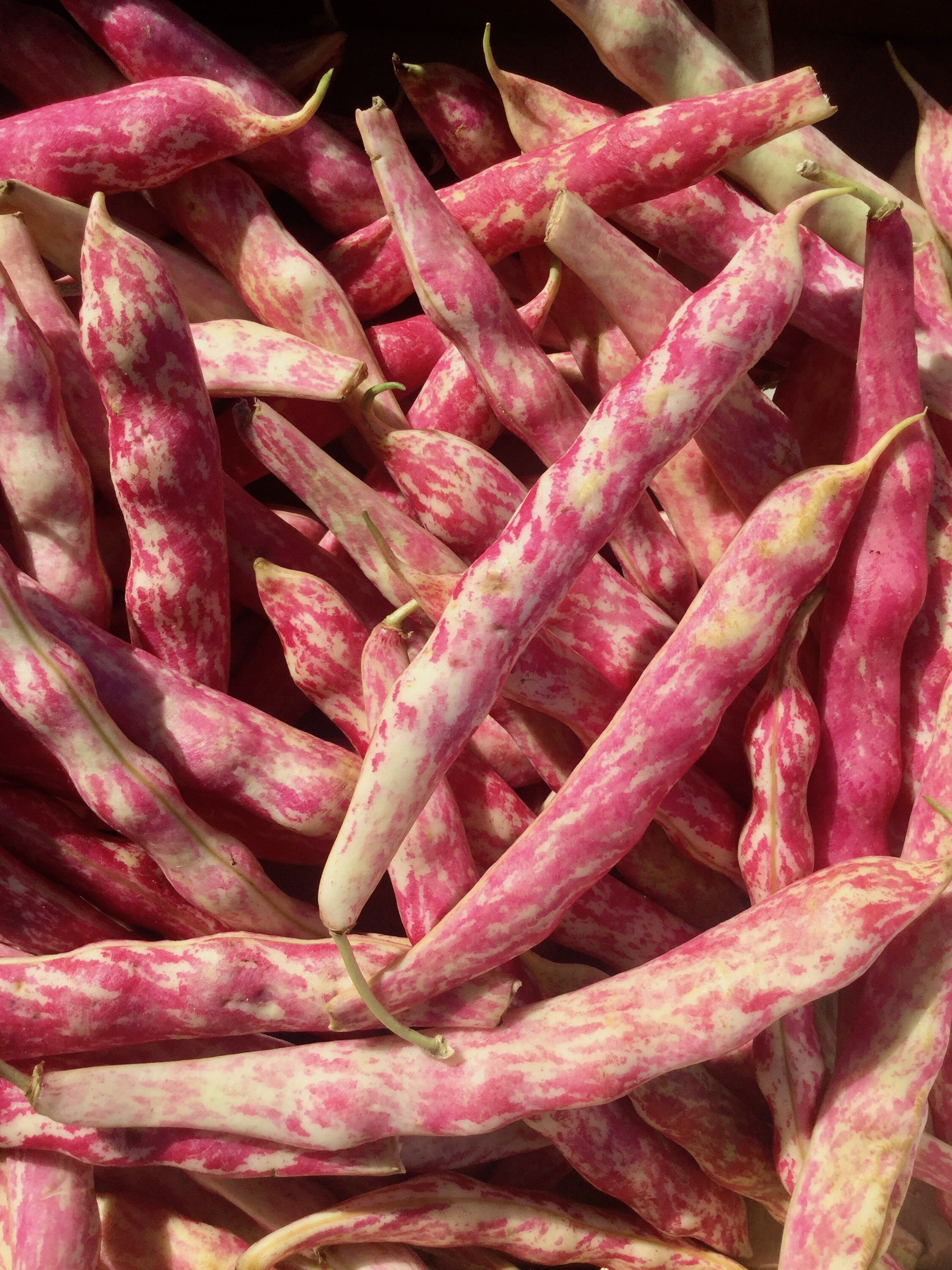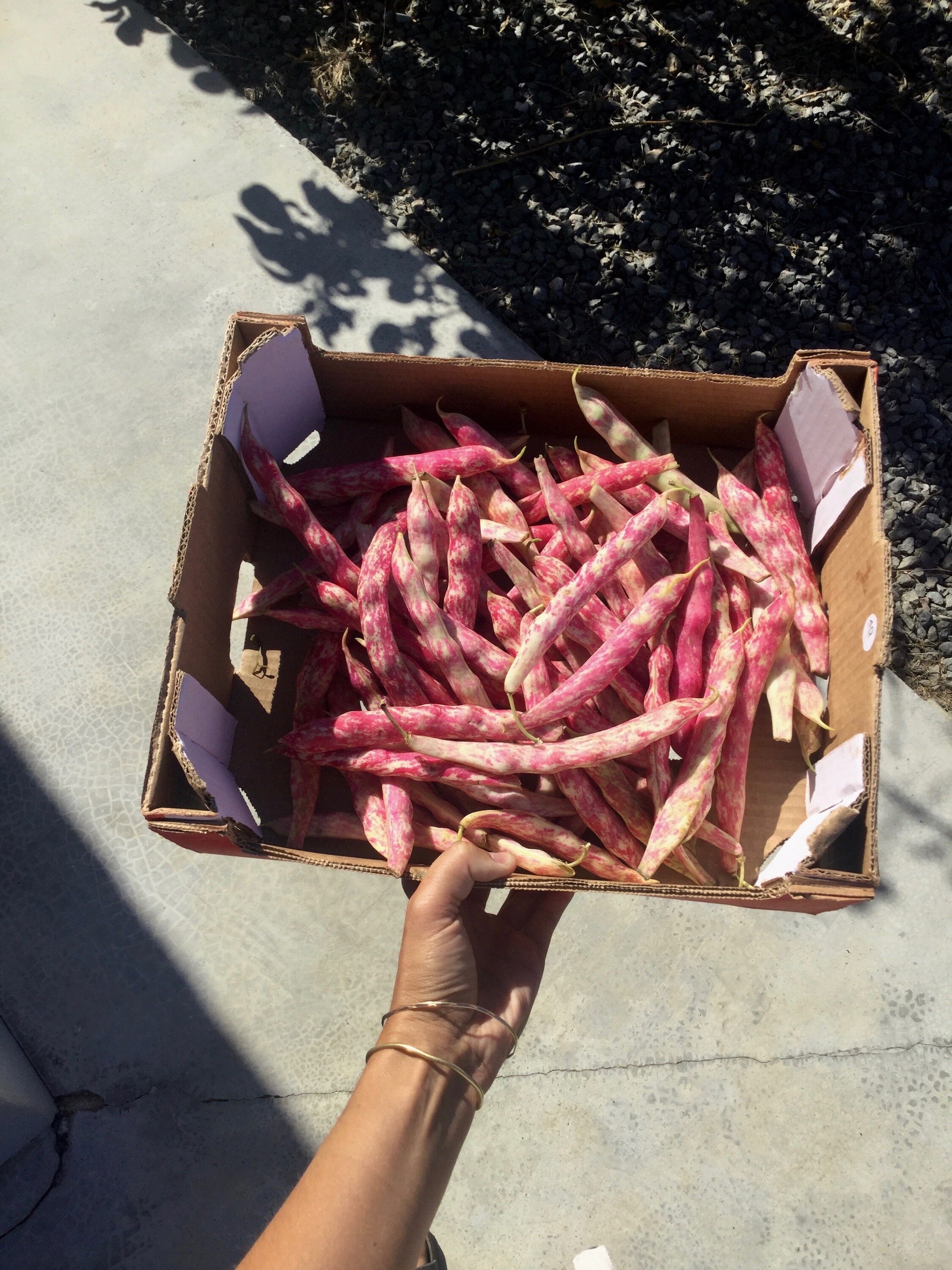#2, AGOSTO
FEIJÕES + FAVAS / MAGIC BEANS
Upon arrival in Portugal, fresh off the highway from Spain, I was taken to the freguesia in Vila Nova de Milfontes to scope out the local produce. Amidst well-trodden tiled floors, fish-laden marble countertops, and echoed exchanges in a language I didn’t yet understand, my eyes were drawn towards a bucket brimming with pistachio-dappled fuchsia beans. And next to it, another bucket filled with vivid, matte green ones. I had never seen such plump, abundant vibrancy. I had also never cooked with them from scratch… Regardless, I filled a box and decided now was the time to try.
That afternoon, nestled into a grassy patch near the lemon tree, I began separating the beans from their pods. It took some time. Sam, the farm dog, eschewed his usual preference for shade and came to lie down next to me. The sun moved slowly overhead. The peacocks went about their business. Life moved on around me. Without any intention to do so, I found my mind emptying (or at least quieting) and a sense of ease, of genuine unfettered contentment, permeating my position.
Wanting to weave them into the night’s dinner menu, but unsure of how to use my freshly-freed pulses, I pulled out a stack of recipe books and searched the indexes for inspiration. Alongside fava bean soup with morcilla, beetroot salad, and salt cod carpaccio, a section in MORO EAST by Sam & Sam Clark describes their Tuscany-derived ritual for bean harvest time: friends and family gather round a table piled high with the season’s first crop, and plates of pecorino (or jamón ibérico, if in Spain) with copas of chilled, fino sherry are dispersed; the sipping and snacking lubricating an unhurried communal effort centred simply around the task at hand. It is an opportunity to relax into and derive pleasure from the process itself, and not to forsake or mistake it as merely prep for another, better, more important venture.
I’ve noticed that moments like these sometimes give rise to the most needed of unstudied, unfiltered conversations. With everyone’s primary focus dissolving into the meditative effects of repetitious activity, the mind’s windows open up to release what lies just beneath that first flimsy skin of protective dialogue. I don’t believe that good conversations can be rushed, coerced, or pre-paced based on a presumed script. Often we need time — and a collaborative pursuit (like shelling beans!) that provides us with easy, unpoliticized common ground — to allow a truer, more natural interchange to unfurl.
That Summer, I didn’t have immediate family and friends to share the process with. I turned the cooked beans into a sumac and feta-melded “crush” that was later spread on toast and loaded with fresh herbs. The weeks and months rolled on, and changing seasons ensured that different fruits and vegetables garnered my attention. Friendships began to take root, but family still felt far away.
A couple of weeks ago, I noticed Miguel sitting under the fig tree with a huge crate full of favas. When I wandered over to inquire, he said they had just been harvested from our own land, and needed to be shelled and cooked while they were still fresh. I sat down, and began to peel. Real family members showed up, “just dropping by to say hi”, and joined in. Trainees from the program-in-session scattered the lawn, laughing and helping each other prepare for final teaches. The chickens, roaming wild across the farm, clucked and pecked their way through the dust. It occurred to me that this was a kind of family too. Unplanned and unexpected, but nonetheless tethered by time and place and circumstance. Apart from bloodlines, what else binds us?
The Portuguese word for beans is FEIJÕES, and the residue from my particular cocktail of cultural cross-pollination means that when spoken, I can’t help but transmute it to FAIS JOIE; make joy.
I invite you to gather some proverbial beans, and set about shelling them with whatever family your current reality has provided for you. If real-life human people are not included in that scenario for now, here is a recipe designed to offer you pause, pleasure, and comfort; an invitation to ease. I’m convinced that it will work with whatever spring / summer vegetable you can substitute if fava beans are not available in your area. I would, however, encourage choosing one that requires a little prep. A little peeling, a little podding, just something that allows you the aperture to soften into the process; to pour a glass of wine, to throw on the soundtrack from Call Me By Your Name, and perhaps to leave something bubbling on the stove while you phone an old friend or write a postcard to a loved one, letting them know that they, too, are family; perennially tethered by time, place, and circumstance.
SPRING PASTA
Serves ONE. Why are there so few recipes out there for a solitary diner?!
I believe cooking a fine meal for yourself is an act of devotion,
one that is ultimately in service of those proximate to you.
So this one’s for one. Couples can double.
Ingredients [potential subs in brackets]
Butter [Olive Oil], 2 Tbsp
Onion, 1/2, chopped finely
Hazelnuts, [Walnuts] 3 Tbsp, roughly chopped
Garlic, 2 cloves, sliced or minced
Flaky Sea Salt, about 2 tsp
Fava Beans [Summer Veg], a handful of podded beans
Black Pepper, a few generous grinds
Cava, [Prosecco, White Wine, Dry Sherry] a glug
Your Favourite Pasta, something short, not spaghetti / linguine, 2 handfuls
Lemon, 1, zest finely grated
Chilli Flakes, 1/2 tsp
Fresh Mint Leaves [Basil or Parsley will alter the finished flavour but still work beautifully] a small handful, roughly chopped
Rocket [Watercress, peppery Micro Greens], a handful
Parmesan [Grana Padano / Pecorino / Cured Goats Cheese], as much as you like - don’t hold back - grated
*
Cook your pasta in salted water until just shy of al dente (it will cook a little more in the sauce later) and drain, reserving about a cup of the pasta water.
In a frying pan, heat the butter until completely melted then add the onion, stirring frequently and allowing to cook until translucent and beginning to turn golden-brown at the edges (a low and slow heat here will deliver a sweet, caramelized flavour), then add the hazelnuts, and stir intermittently for a few minutes. Add a splash of olive oil if it’s looking dry.
Once the nuts are smelling nice and toasty, add the garlic, a hearty pinch of salt, and keep stirring until fragrant (be careful not to let the garlic overcook).
Add your fava beans and black pepper, stirring well to coat everything in the buttery garlic mix. Add a decent splash of cava, stir, then let everything bubble away for a little while, adding spoonfuls of pasta water if needed to keep it saucy. In the meantime, you can grate some parmesan.
Finally, stir in the lemon zest, chilli flakes and cooked pasta, lowering the heat and giving everything a minute or two to meld before tasting for seasoning. Adjust according to your palette.
Just before serving, stir the fresh mint through the pasta, tip into your favourite bowl, and top with a handful of rocket, the parmesan, and another few grinds of black pepper.
WRITING + PHOTOGRAPHY by NAT DOLLIN
Nat is working to cultivate a vivid life from the inside out.
Attentive to subtleties, reverent before horizons, and appreciative
of tequila, curiosity towards paradox drives her to ceaselessly
weave between extremes, insofar as the tapestry yields insight.







